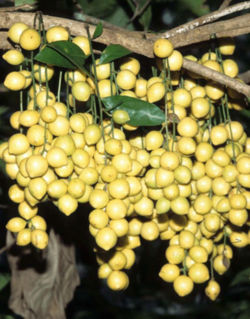Burmese grape: Difference between revisions
No edit summary |
(No difference)
|
Latest revision as of 13:03, 10 November 2007
| Baccaurea ramiflora {{{status}}} Fossil range: {{{fossil_range}}}
| ||||||||||||||||||||||||||||||||||||||||||||||||||||||||||||||||||
|---|---|---|---|---|---|---|---|---|---|---|---|---|---|---|---|---|---|---|---|---|---|---|---|---|---|---|---|---|---|---|---|---|---|---|---|---|---|---|---|---|---|---|---|---|---|---|---|---|---|---|---|---|---|---|---|---|---|---|---|---|---|---|---|---|---|---|
 | ||||||||||||||||||||||||||||||||||||||||||||||||||||||||||||||||||
| Plant Info | ||||||||||||||||||||||||||||||||||||||||||||||||||||||||||||||||||
| ||||||||||||||||||||||||||||||||||||||||||||||||||||||||||||||||||
| Scientific classification | ||||||||||||||||||||||||||||||||||||||||||||||||||||||||||||||||||
| ||||||||||||||||||||||||||||||||||||||||||||||||||||||||||||||||||
| [[{{{diversity_link}}}|Diversity]] | ||||||||||||||||||||||||||||||||||||||||||||||||||||||||||||||||||
| {{{diversity}}} | ||||||||||||||||||||||||||||||||||||||||||||||||||||||||||||||||||
| Binomial name | ||||||||||||||||||||||||||||||||||||||||||||||||||||||||||||||||||
| Baccaurea ramiflora Lour. | ||||||||||||||||||||||||||||||||||||||||||||||||||||||||||||||||||
| Trinomial name | ||||||||||||||||||||||||||||||||||||||||||||||||||||||||||||||||||
| {{{trinomial}}} | ||||||||||||||||||||||||||||||||||||||||||||||||||||||||||||||||||
| Type Species | ||||||||||||||||||||||||||||||||||||||||||||||||||||||||||||||||||
| {{{type_species}}} | ||||||||||||||||||||||||||||||||||||||||||||||||||||||||||||||||||
| {{{subdivision_ranks}}} | ||||||||||||||||||||||||||||||||||||||||||||||||||||||||||||||||||
| [[Image:{{{range_map}}}|{{{range_map_width}}}|]] | ||||||||||||||||||||||||||||||||||||||||||||||||||||||||||||||||||
| Synonyms | ||||||||||||||||||||||||||||||||||||||||||||||||||||||||||||||||||
| {{{synonyms}}} |
The Burmese grape (Baccaurea ramiflora, Family: Phyllanthaceae) is a slow growing evergreen tree growing to 25 m, with a spreading crown and thin bark. It is found throughout Asia, most commonly cultivated in India and Malaysia. It grows in evergreen forests on a wide range of soils. The fruit is harvested and used locally, eaten as a fruit, stewed or made into wine; it is also used medicinally to treat skin diseases. The bark, roots and wood are harvested for medicinal uses.
The fruit is oval, colored yellowish, pinkish to bright red or purple, 2.5-3.5 cm in diameter, glabrous, with 2-4 large purple-red seed, with white aril.
Bark, roots and wood are dried and ground before boiling in water. Fruits can be kept fresh for 4-5 days, or boiled and mixed with salt after which it is keeps well closed jars. Marginal importance of the fruit, locally used and sold.
Other names
- English: Burmese grape
- Thai: mafai, mak fai pa, khi mi, sae khrua sae, somfai, hamkang, pha yio
- Vietnamese: giau gia dhat, giau tien, dzau mien dzuoi, you vo do, bung
- Burmese: kanazo
- Cambodian: phnhiew
- Local names: Phu noi: cha chouay see
- Indian : Le-te-ku